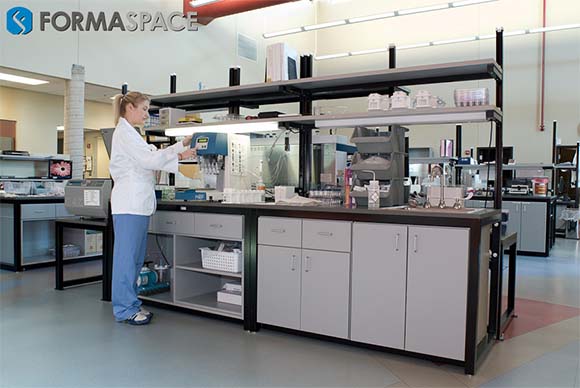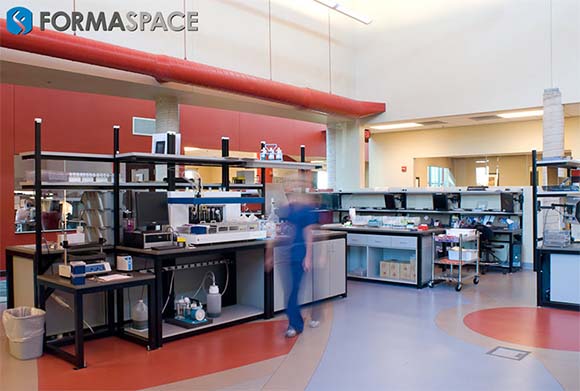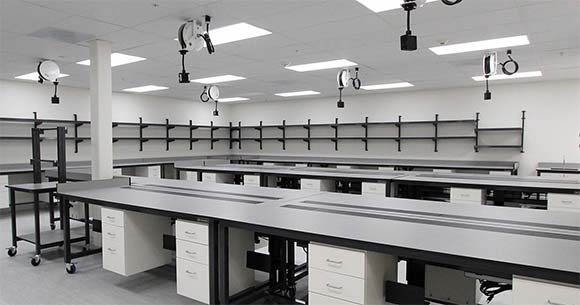Constant vigilance is the watchword to help prevent serious errors while working in a wet lab environment. These recommendations can help you work more safely.
As experienced researchers and technicians know, working in a wet laboratory can be a very dangerous place indeed. Some might say that both Murphy’s Law and the Law of Unintended Consequences work overtime in wet lab environments. But it’s really no joking matter. Making a mistake in the wet lab can have very serious consequences for your own personal health and safety – as well as for those around you.

Physical Dangers to Human Health and Safety in Wet Labs
The combination of infectious agents, sharp tool, and needles, fragile glassware, high-speed centrifuges, and liquefied gases under pressure makes wet laboratories a demanding environment where small mistakes can spell disaster.
Here are just a few of the potential types of accidents that can occur in the wet lab:
- Punctures and cuts from so-called sharps, such as needle sticks, broken pipettes, and glass slides can lead to dangerous Laboratory-Acquired Infections (LAIs).
- Ingestion of chemicals or biological pathogens can occur due to incorrect procedures, such as mouth pipetting, allowing food and beverages in the lab, absentmindedly placing a pen or pencil in the mouth, wearing contact lenses, or using your keyboard or smartphone in the laboratory without a protective cover.
- Inhalation of aerosols, including fungus spores, micro particulates, viruses, or bacteria can be caused by improper fume hood use, unsafe centrifuge handling procedures, opening closed test tubes at close range without proper PPE (personal protective equipment), or mistakes in handling vacuum pumps safely.
- Implosion accidents can occur when vacuum flasks or bell jars fail, resulting in sharp debris from broken glass shooting out into laboratory technician’s unprotected eyes, face or hands.
- Explosions in the laboratory can be caused by multiple factors, including mishandling of liquid gases (such as liquid nitrogen, helium or oxygen) in cryogenic containers, or the accidental mixing of incompatible compounds due to handling errors caused by mislabeled or LASA (look-alike, sound-alike) compounds.
Consequences of Lab Errors: What is the True Cost?
There’s not a central database that documents the cost of errors made in wet laboratories, at least not yet.
A Blue-Ribbon Panel set up by the CDC (Centers for Disease Control) is on record asking for a voluntary, non-punitive surveillance and reporting system – where anonymous participants could submit accident reports – with the intent that the greater laboratory science community could learn to prevent repeating mistakes again in the future.
In the meantime, different agencies do report on lab accidents and their associated costs, including the CDC itself, which publishes their Morbidity and Mortality Weekly Report (MMWR).
According to the CDC’s MMWR reports, bacteria is responsible for more than 40% of laboratory-acquired infections; more than 37 different bacteria species have been identified as common etiologic agents.
Among viruses, Hepatitis B is the most frequent laboratory-acquired viral infection; laboratory workers are infected with Hepatitis B at a rate that is 2 to 4 times that of the general population.
How do laboratory workers acquire these infections? According to the CDC, the five most prominent sources of laboratory-acquired infections are:
- Accidental inoculation by syringe needles or contaminated sharps.
- Spills and splashes on skin or mucous membranes.
- Ingestion or exposure by mouth pipetting or touching the mouse or eyes with fingers or contaminated objects.
- Laboratory research activities involving animal bites or scratches.
- Inhalation of infectious aerosols.
Reported statistics indicate that items 1 through 4 account for 20% of Laboratory-Acquired Infections (LAIs). What about the other 80%? The answer is we often don’t know for sure – it’s very difficult in practice to identify a specific event causing an infection, but it’s suspected that inhalation of infectious aerosols is a major cause of LAI’s.
What’s the Cost of Errors by Diagnostic Labs to the Healthcare System?
Errors made by diagnostic labs can have life or death consequences for patients in the healthcare system who are relying upon laboratory test results.

Frustratingly, the most common medical “laboratory errors” seem to be outside the laboratory. According to a study by ECRI Institute PSO, only 4% of nearly 2500 laboratory events (e.g. errors) occurred in the lab itself.
The main culprits were in the Pre-analytical phase:
- Mislabeled specimens
- Specimens with no label or an incomplete label
and in the Post-Analytical phase:
- Test results that were delayed or missing
Earlier this year, Alia Atwaru MHA, of Northwell Health Labs (NWL) presented a study to the American Society for Clinical Pathology that quantifies the economic cost of diagnostic laboratory test errors at somewhere between $200 – $2000 per error.
To be clear, these figures estimate the economic cost of having to repeat laboratory tests. While these numbers do represent a significant amount of money wasted on unnecessary, duplicate lab tests, these costs pale in comparison to the potentially serious health consequences to a patient stemming from faulty laboratory tests. Examples of some of the more severe consequences include:
- Unnecessary surgery or treatments performed on the patient, due to an inaccurate lab
- Surgery or medically necessary treatments not performed on the patient, due to an inaccurate lab
- Misdiagnosis and improper treatment of a patient, due to an inaccurate lab
As you are certainly aware, any of the above scenarios could have life or death consequences, and be subject to actionable malpractice cases costing upwards of millions of dollars.
What Systematic Changes Can Reduce Wet Lab Mistakes?
Laboratory experts agree that more needs to be done to improve laboratory safety.
In the case of diagnostic laboratories, the CDC has published a document called Guidelines for Safe Work Practices in Human and Animal Medical Diagnostic Laboratories, which outlines their existing research and specific recommendations to improve safety.
The engineering methodology known as Root Cause Analysis (RCA) can be applied to determine the underlying causes of a mistake or accident. Often, there is more than one contributing cause. Aircraft safety experts refer to this as the “Swiss cheese model” where inherently unsafe conditions are represented by holes in a large piece of cheese. Accidents can be prevented by ensuring that there are multiple layers of overlapping safety measures and procedures. However, unforeseen accidents can occur when all the holes in the cheese line up in a row.
Today’s accident prevention research also focuses on what are known as Human Factors and System Issues. The study of Human Factors researches how humans respond in different scenarios, such as working with automated systems (the man/machine interface) such as laboratory test equipment, how we make decisions when presented with conflicting information, as well as how we work together with other people to solve problems. The study of System Issues focuses on eliminating inconsistent or unnecessary procedures that can result in unwanted errors.
Learning from errors is also an important part of improving safety culture.
In a litigious society, there is often a major obstacle: getting people to admit mistakes. This is especially true if the participants know they will be subject to punishment – such as temporary suspension, financial penalties, job termination, licensure revocation or decertification.
In response, the concept of a “Just Culture” was developed to collect valuable safety information without the fear of recrimination. We may see this “Just Culture” approach more widely applied in the future in laboratory science. (See the recommendations by a CDC Blue-Ribbon Panel to create an anonymous national lab error-reporting database noted earlier in the article.)
What Can We Do as Individuals to Help Reduce Errors in Wet Labs?
How can we improve our performance as researchers and technicians in wet laboratories?
Let’s look at a sports coaching analogy. If you’re learning a new skill, such as performing an unfamiliar high-stakes experiment for the first time, why not take the time to prepare yourself mentally by practicing these steps:
- Stay focused by making sure you are well-rested. If you are unable to get a proper night’s sleep, you will be more accident prone the following day. The same goes for maintaining a reasonable work schedule. If you are working more ten hours in a day or you avoid taking adequate breaks, you won’t perform as well as you should.
- Get familiar with all the tools and equipment that you need to conduct the experiment. Take a quiet moment to visualize each of the steps required in your mind.
- Have you practiced doing the experiment when you are geared up with all the necessary personal protective equipment (PPE), such as eye and face protection and gloves? It will be more difficult that way, so practice first.
- Why not practice the necessary movements using inert chemicals as part of a dry run, before attempting work with dangerous materials?
- Don’t rush. Take your time to do each step, deliberately and thoughtfully in order to avoid mistakes, such as dropping beakers or neglecting to use fume hoods properly. Take time to follow written checklists and record information.
- Confer with your colleagues or management if things don’t feel right or if you have questions about procedures that could be more streamlined or safer.
Lab Professionals Need to Use Professional Grade Equipment
Let’s continue with our sports analogy. If you’re a professional ballplayer, would you want to go on the field with inferior or broken equipment? No, as a professional, you know the value of investing in state-of-the-art equipment and treating it with respect.

Inspect your equipment — is everything in its place?
- Do you need additional space to work?
- Is your workstation ergonomically designed so you can work more effectively?
- Are your work surfaces clean and well lit?
If items are piling up, that’s a bad sign. Make a list of what needs to be properly stored.
- Do you need additional biosafety cabinets?
- Are there sufficient places to safely dispose of contaminated waste?
As you perform each experiment, consider what could go wrong.
- Is the personal protective equipment stored logically in a way that reminds you to use it properly?
- Do need to install additional splash guards to protect your face, eyes and skin from accidental exposure?
- Is the fume hood certified for using the chemicals you are currently using?
Formaspace Cares about Your Laboratory Safety
Working in a fast-paced laboratory environment can be exciting, but you need to take the proper steps to ensure everyone’s safety.
Talk to one of our Formaspace design consultants today to learn how to make your laboratory a better, safer, and more productive place to work.
Whether you’re planning your next custom design wet lab to make enhancements to your existing facility, Formaspace can help. Contact us today.












